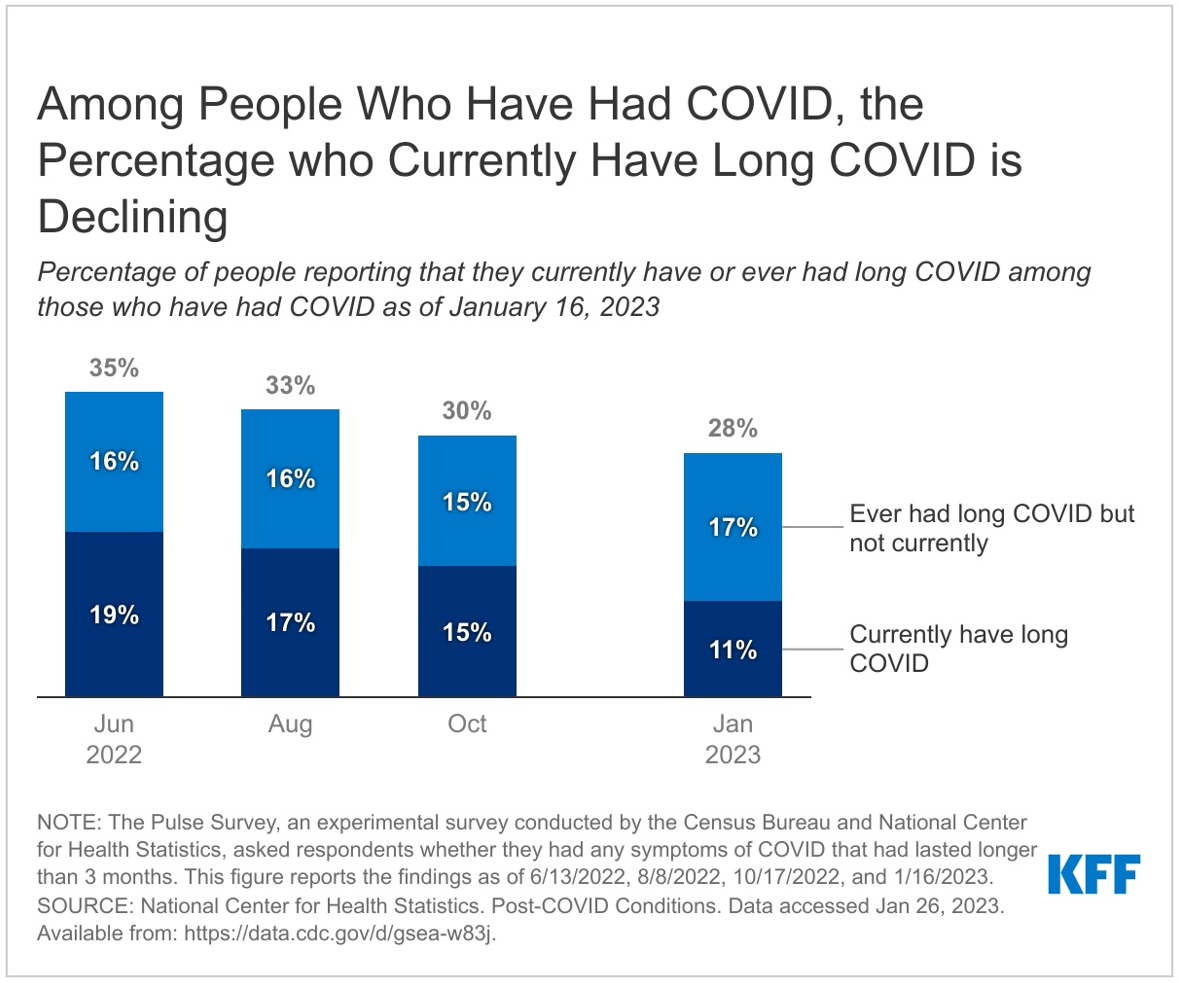As of January 25, 2023, Centers for Disease Control and Prevention (CDC) data show that COVID cases, deaths, and hospitalizations have stabilized after a small surge around the holidays. However, there is still a great deal of uncertainty about long COVID and whether there will be increased long COVID cases following the holiday bump. (The working definition of long COVID is “signs, symptoms, and conditions that continue or develop after initial COVID-19 or SARS-CoV-2 infection.) Although the evidence is mixed as to whether vaccines reduce the likelihood of getting long COVID, or if they reduce the severity of long COVID among people who already have it, only 15% of the population up to date on their vaccines. Within this context, we examine the latest data on long COVID from the Household Pulse Survey, as reported by the CDC. Previous research has highlighted the implications of long COVID for employment and health coverage and it’s potential to exacerbate existing disparities in those areas. The latest data and research suggest that those concerns are important but also show that among people who have had COVID, the percentage with long COVID is declining (Figure 1).
The percentage of people who have had COVID and currently report long COVID symptoms declined from 19% in June 2022 to 11% in January 2023. That decrease reflects a reduction in the share of people who have COVID and later report long COVID, which declined from 35% to 28% during the same period. Despite the decline, the rate of long COVID among people who have had COVID remains high. It is in line with other research and federal reports, but higher than some other studies have found (see for example, another survey in the U.S.). As of January 16, 2023, 15% of all adults in the US reported having had long COVID symptoms at some point and 6% reported current symptoms.
Among those who have ever had long COVID, over half are no longer reporting symptoms. Among people who have had COVID, 11% are currently experiencing long COVID but an additional 17% had long COVID in the past and are no longer reporting symptoms. Those numbers suggest that more people have recovered from long COVID than currently report symptoms. That finding is similar to a study of Israel, which found that most symptoms of long COVID resolved within a year, although that study was limited to people with mild illness.
Among people with long COVID, 79% report having limitations to their day-to-day activities and 27% characterize the limitations as significant. The Pulse survey asks people who report having long COVID whether it limits their day-to-day activities and most people with long COVID report activity limitations. Only a quarter report that the limitations are significant. It is uncertain how well Pulse respondents represent all U.S. adults. On the one hand, it may be difficult for people with severe limitations to respond to the survey, so the survey may undercount people with severe limitations from long COVID. On the other hand, people who experience long COVID and especially, limitations from long COVID, may be more likely to respond to the survey, so the survey may overcount people with activity limitations from long COVID. Understanding the severity of limitations and whether they are permanent is relevant to the uncertainty surrounding how long COVID will affect employment. Estimates of the effects of long COVID on the workforce range from 500,000 or possibly even fewer to as many as 4 million.
Looking ahead, although a smaller percentage of people with COVID are reporting long COVID, 5% of the adult population is struggling with activity limitations from long COVID. A recent study highlights the myriad of ways in which long COVID presents, noting that many people may have lifelong disabilities as a result. Among people who currently have long COVID, many have trouble accessing the health care they need. Patients often visit many specialists before getting a diagnosis and when they have a diagnosis, struggle to find a provider on account of provider shortages. Providers themselves wrestle with uncertainty regarding the course of treatments most likely to help. Among people with activity limitations who are unable to work, many have trouble accessing disability benefits through their workplaces or through federal disability insurance programs. Because long COVID is more common among people with lower levels of education, it is likely that people in low-wage jobs without benefits are overrepresented among those unable to work on account of long COVID. That combination of factors has serious implications for the health and well-being of people with long COVID and for their families.
Longer-term, it is unclear what is driving the reduced percentage of people with COVID who report having long COVID and whether current trends will continue. The change could stem from changes in SARS-CoV-2, the virus that causes COVID, or from increasing population immunity through vaccination and prior infection. In August 2022, the Department of Health and Human Services released a National Research Action Plan on long COVID aimed at providing a call to action for public and private researchers to accelerate their work. The federal RECOVER initiative aims to understand how people recover and why some people don’t. That initiative coupled with on-the-ground research and work by doctors and long COVID clinics could help to increase long COVID recovery rates and to identify how to best care for those who do not recover.

